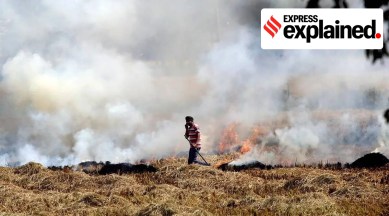How replacing coal with paddy straw in brick kilns can help address stubble burning menace
In a letter to brick kiln owners, the PPCB has said that the Punjab government is formulating a policy for the mandatory replacement of 20% coal with paddy straw-based pellets.

The Punjab Pollution Control Board (PPCB) wants brick kiln owners in the state to replace at least 20% coal with the paddy-straw pellets for fuel requirements in the kilns.
The PPCB believes that this will help tackle the problem of stubble burning in the state.
The proposal
In a letter to brick kiln owners, the PPCB has said that the Punjab government is formulating a policy for the mandatory replacement of 20% coal with paddy straw-based pellets. This is based on a study conducted jointly by the Punjab State Council For Science and Technology (PSCST) and PPCB regarding the partial replacement of coal with paddy straw pellets with an aim to reduce air pollution while ensuring economic benefit for kiln owners. A draft notification in this regard has already been issued by the state’s Department of Science, Technology and Environment, and public comments invited.
The rationale
There are around 2,700 kilns in Punjab out of which nearly 2,100 have been upgraded and are in operation currently. The average coal consumption of a kiln, which runs for 6-7 months in a year, is around 900 tonnes of coal (with upgraded technology).
So, the coal consumption of these operational kilns’ would come to around 19 lakh tonnes per year, costing around Rs 4,750 crores. The cost of one-tonne coal is around Rs 25,000 including the freight rate.
In Punjab, kilns are operated two times from October to December and February to July in a year.
A brick kiln, which is usually 120-ft high (part of which is under the earth), has around 36 chambers in which about 10-12 lakh clay bricks are placed for drying or hardening.
Brick kiln owners said that the replacement of 20% coal with stubble pellets means that nearly 200 tonnes of coal burning can be reduced in every kiln per year (and to a total of 4.20 lakh tonnes worth Rs 1,050 crores).
For replacing this 4.20 lakh tonnes of coal, nearly 10 lakh tonnes of stubble pellets are required because the consumption of pellets would be more than double as compared to coal.
Is it possible?
Using paddy stubble pellets in the kilns is no big deal, said kiln owners.
“Kiln can be run 100% on paddy stubble pellets fuel,” said a Hoshiarpur-based brick kiln owner of Tata Bricks, Shiv Walia. He added that if it is done then Punjab’s 40 to 50 lakh tonnes of stubble can be used in the kiln industry alone.
“We even propose to replace 50% coal with stubble pellets in the beginning and then it should be increased to 100%,” he added.
In Punjab, 220 lakh tonnes of paddy stubble is produced annually out of which nearly 100 lakh tonnes of stubble is managed currently through in-situ and ex-situ methods and the remaining 120 lakh tonnes gets burnt on the fields. If all kilns use paddy stubble pellets then 40% of the non-managed 120 lakh tonnes of stubble can be used here, said PPCB sources.
The cost argument
It will be much cheaper as compared to coal, said experts. Collection, transportation and storage of paddy does not cost more than Rs 3,000 per tonne and the remaining is the expenditure on processing. PPCB sources said that it can save them at least 500 to 600 crores annually.
Good for the environment?
The paddy stubble fuel is environmentally friendly as it does not contain a high amount of sulphur like coal.
According to the Department of Science and Technology and Environment, it can help achieve the stringent emission standard for particulate matter (PM) that is set for the brick kilns.
The roadblocks
Kilns can only use paddy straw in pellet form. This conversion is a tedious process, and there are not enough facilities in the state to do that.
“Processing of paddy stubble into pellets is a bit difficult because of the high amount of silica in it,” said a member of the Punjab Brick Kiln Owner Association.
Kiln owners want government support for setting up such pallet units at district level and also supply of quality fuel at competitive prices.